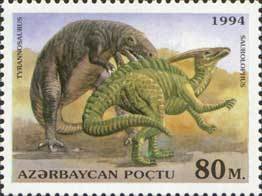Stamp: Tyrannosaurus, Saurolophus (Azerbaijan 1994)
Tyrannosaurus, Saurolophus (Azerbaijan 1994)
15 September (Azerbaijan ) within release Prehistoric Animals goes into circulation Stamp Tyrannosaurus, Saurolophus face value 80 Azerbaijani manat
| Stamp Tyrannosaurus, Saurolophus in catalogues | |
|---|---|
| Michel: | Mi:AZ 159 |
Stamp is horizontal format.
Also in the issue Prehistoric Animals:
- Stamp - Coelophysis, segisaurus face value 5;
- Stamp - Pentaceratops, Tyrannosaurus face value 10;
- Stamp - Segnosaurus, Oviraptor face value 20;
- Stamp - Albertosaurus, Corythosaurus face value 25;
- Stamp - Iguanodon face value 30;
- Stamp - Stegosaurus, Allosaurus face value 50;
- Stamp - Tyrannosaurus, Saurolophus face value 80;
- Souvenir Sheet - Phobetor face value 100;
Stamp Tyrannosaurus, Saurolophus it reflects the thematic directions:
Reptiles are tetrapod (four-limbed vertebrate) animals in the class Reptilia, comprising today's turtles, crocodilians, snakes, amphisbaenians, lizards, tuatara, and their extinct relatives. The study of these traditional reptile orders, historically combined with that of modern amphibians, is called herpetology. Because some reptiles are more closely related to birds than they are to other reptiles (e.g., crocodiles are more closely related to birds than they are to lizards), the traditional groups of "reptiles" listed above do not together constitute a monophyletic grouping (or clade). For this reason, many modern scientists prefer to consider the birds part of Reptilia as well, thereby making Reptilia a monophyletic class.
Dinosaurs are a diverse group of reptiles of the clade Dinosauria. They first appeared during the Triassic period, between 243 and 233.23 million years ago (mya), although the exact origin and timing of the evolution of dinosaurs is a subject of active research. They became the dominant terrestrial vertebrates after the Triassic–Jurassic extinction event 201.3 mya and their dominance continued throughout the Jurassic and Cretaceous periods. The fossil record shows that birds are feathered dinosaurs, having evolved from earlier theropods during the Late Jurassic epoch, and are the only dinosaur lineage known to have survived the Cretaceous–Paleogene extinction event approximately 66 mya. Dinosaurs can therefore be divided into avian dinosaurs—birds—and the extinct non-avian dinosaurs, which are all dinosaurs other than birds.


